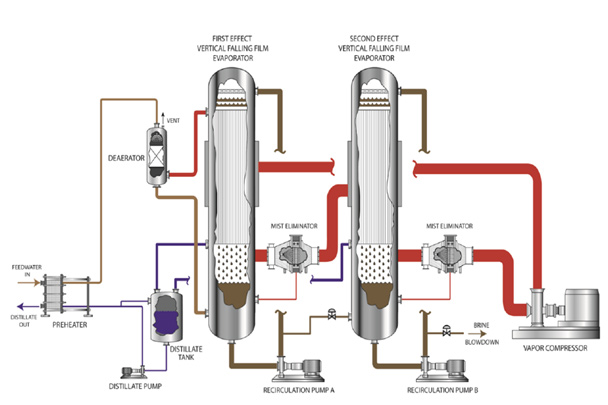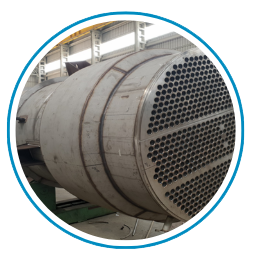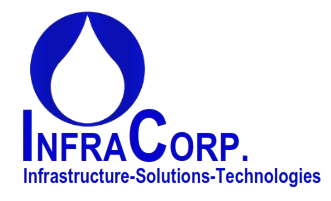Thermal Evaporator
Advanced Thermal Concentration for High-Salinity and Hard-to-Treat (H2T)Waters
The InfraCorp Evaporator is a high-efficiency thermal evaporation system engineered to recover clean water and minimize brine volumes from saline or industrial wastewater. Designed around InfraCorp’s philosophy of Hard-to-TreatTechnology (H2T™), this process enables reliable concentration of RO reject, process effluent, and high-TDS brines—serving as a critical bridge between membrane treatment and Zero LiquidDischarge (ZLD) crystallization.
evaporator is a core unit operation in thermal water treatment, desalination, and Zero Liquid Discharge (ZLD) systems — designed to remove water by evaporation, thereby concentrating dissolved solids, salts, or contaminants.
It serves as a front-end or complementary stage to crystallizers, brine concentrators, or distillation systems in both industrial and municipal applications.

Core Operating Principles
- Operates under vacuum to lower boiling temperature (reducing energy demand).
- Heat is transferred through tube bundles or plates using steam, waste heat, or mechanical vapor recompression (MVR).
- Often used in multi-effect or forced-circulation configurations for improved efficiency.
What an Evaporator Does
- Heats liquid feed (such as saline water or wastewater) to its boiling point,
- Evaporates water (forming vapor),
- Condenses the vapor into distillate (clean water), and
- Retains concentrated brine or slurry as residue.
In many systems, the goal is to maximize distillate recovery while minimizing energy use and scaling.
Common Types of Evaporators
|
Type |
Description |
Typical Use |
|
Falling Film Evaporator |
Thin film of liquid flows down heated tubes; high efficiency and gentle operation. |
Low-scaling, heat-sensitive feeds. |
|
Forced Circulation Evaporator (FCE) |
Feed is circulated rapidly through heat exchanger to prevent scaling. |
High-TDS or fouling brines. |
|
Multiple-Effect Evaporator (MEE) |
Uses vapor from one effect as heat for the next, reducing energy use. |
Large-scale ZLD or industrial systems. |
|
Mechanical Vapor Recompression (MVR) |
Compresses vapor to reuse latent heat; highly energy-efficient. |
Power plants, RO brine concentration. |
|
Agitated Thin Film Evaporator (ATFE) |
Rotating blades spread liquid as thin film; ideal for viscous or slurry feeds. |
Concentrated sludges or organics. |

Performance Metrics
|
Parameter |
Typical Range |
|
Feed TDS |
30,000–200,000 mg/L |
|
Recovery Rate |
85–95% |
|
Distillate Quality |
<10 µS/cm |
|
Energy Use |
10–25 kWh/m³ (depending on type) |
|
Operating Pressure |
0.05–0.3 bar (vacuum) |
Applications
- Desalination (RO reject minimization)
- Industrial wastewater (power plants, textiles, oil & gas, pharma)
- Chemical and fertilizer industries (acid concentration, product recovery)
- ZLD systems (paired with crystallizers for solids recovery)


Evaporator vs. Brine Concentrator
|
Aspect |
Evaporator |
Brine Concentrator |
|
Purpose |
General water removal / concentration |
Advanced concentration of RO brine to near-saturation |
|
Feed Salinity |
10,000–200,000 mg/L |
70,000–300,000 mg/L |
|
Recovery |
Moderate to high |
Very high |
|
Output |
Concentrate or slurry |
Near-saturated brine or feed for crystallizer |
Turnkey Services – From Concept to Commissioning
At InfraCorp, we provide end-to-end turnkey solutions for evaporation and crystallization systems—managing every phase of your project with precision and expertise. From initial design and engineering to fabrication, installation, commissioning, and after-sales support, we serve as your reliable project partner at every step.
With a proven track record of successful collaborations with international conglomerates, and a dedicated global project management team, we ensure timely delivery, seamless execution, and fully operational systems upon handover.Whether it’s a greenfield installation or system upgrade, our turnkey approach guarantees performance, compliance, and peace of mind.
